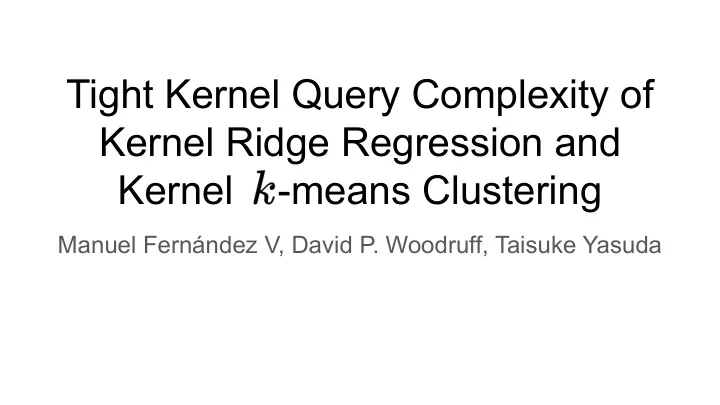

Tight Kernel Query Complexity of Kernel Ridge Regression and Kernel -means Clustering Manuel Fernández V, David P. Woodruff, Taisuke Yasuda
Overview ● Preliminaries ● Kernel ridge regression ● Kernel -means clustering ● Query-efficient algorithm for mixtures of Gaussians
Kernel Method ● Many machine learning tasks can be expressed as a function of the inner product matrix of the data points (rather than the design matrix) ● Implicitly apply the exact same algorithm to the data set under a feature map through the use of a kernel function ● The analogue of the inner product matrix : is called the kernel matrix
Kernel Query Complexity ● In this work, we study kernel query complexity : the number of entries of the kernel matrix read
Kernel Ridge Regression (KRR) ● Kernel method applied to ridge regression ● Approximation guarantee
Query-Efficient Algorithms ● State of the art approximation algorithms have sublinear and data-dependent runtime and query complexity (Musco and Musco NeurIPS 2017, El Alaoui and Mahoney NeurIPS 2015) ● Sample rows proportionally to ridge leverage scores where ● Query complexity
Contribution 1: Tight Lower Bounds for KRR Theorem (informal) Any randomized algorithm computing a -approximate KRR solution with probability at least 2/3 makes at least kernel queries. ● Effective against randomized and adaptive (data-dependent) algorithms ● Tight up to logarithmic factors
Contribution 1: Tight Lower Bounds for KRR Proof (sketch) ● By Yao’s minimax principle, suffices to prove for deterministic algorithms on a hard input distribution ● Our hard input distribution: all ones vector for the target vector , regularization
Contribution 1: Tight Lower Bounds for KRR ● Data distribution for the kernel matrix:
Contribution 1: Tight Lower Bounds for KRR ● Inner product matrix of standard basis vectors, copies of for the first coordinates, and copies of the next ● Half of the data points belong to “large clusters”, the other half belong to “small clusters” ● In order to label a row as “large cluster” or “small cluster”, any algorithm must read entries of the row ● In order to label a constant fraction of rows, need to read entries of the kernel matrix
Contribution 1: Tight Lower Bounds for KRR Lemma Any randomized algorithm for labeling a constant fraction of rows of a kernel matrix drawn from must read kernel entries. ● Proven using standard techniques
Contribution 1: Tight Lower Bounds for KRR Reduction Main Idea: one can just read off the labels of all the rows from the optimal KRR solution, and one can do this for a constant fraction of the rows from an approximate KRR solution.
Contribution 1: Tight Lower Bounds for KRR ● Let be the SVD of the kernel matrix ● The columns are the eigenvectors of and the cluster size is the corresponding eigenvalue, and these are orthogonal ● The target vector is the sum of these columns
Contribution 1: Tight Lower Bounds for KRR
Contribution 1: Tight Lower Bounds for KRR Optimal KRR solution
Contribution 1: Tight Lower Bounds for KRR Optimal KRR solution Thus, the entries are separated by a multiplicative factor.
Contribution 1: Tight Lower Bounds for KRR Approximate KRR solution ● By averaging the approximation guarantee over the coordinates, we can still distinguish the cluster sizes for a constant fraction of the coordinates
Contribution 1: Tight Lower Bounds for KRR
Contribution 1: Tight Lower Bounds for KRR Remarks ● Settles a variant of an open question of El Alaoui and Mahoney: is the effective statistical dimension a lower bound on the query complexity? (they consider an approximation guarantee on the statistical risk instead of the argmin) ● Techniques extend to any indicator kernel function, including all kernels that are a function of the inner product or Euclidean distance ● Lower bound is easily modified to an instance where the top singular values scales as the regularization
Kernel -means Clustering (KKMC) ● Kernel method applied to -means clustering ● Objective: a partition of the data set into clusters that minimizes the sum of squared distances to the nearest centroid ● For a feature map , objective function is
Contribution 2: Tight Lower Bounds for KKMC Theorem (informal) Any randomized algorithm computing a -approximate KKMC solution with probability at least 2/3 makes at least kernel queries. ● Effective against randomized and adaptive (data-dependent) algorithms ● Tight up to logarithmic factors
Contribution 2: Tight Lower Bounds for KKMC ● Similar techniques, hard distribution is sums of standard basis vectors
Kernel -means Clustering of Mixtures of Gaussians ● For input distributions encountered in practice, previous lower bound may be pessimistic ● We show that for a mixture of isotropic Gaussians, we can solve KKMC in only kernel queries
Contribution 3: Query-Efficient Algorithm for Mixtures of Gaussians Theorem (informal) Given a mixture of Gaussians with mean separation , there exists a randomized algorithm which returns a - approximate -means clustering solution reading kernel queries with probability at least 2/3.
Contribution 3: Query-Efficient Algorithm for Mixtures of Gaussians Proof (sketch) ● Learn the means of the Gaussians in samples (Regev and Vijayaraghavan, FOCS 2017) ● Use the learned means to identify the true means of Gaussians ● Subtract off Gaussians from the same mean from each other to obtain zero-mean Gaussians ● Use the zero-mean Gaussians to sketch the data set in samples ● Cluster the sketched data set
Recommend
More recommend